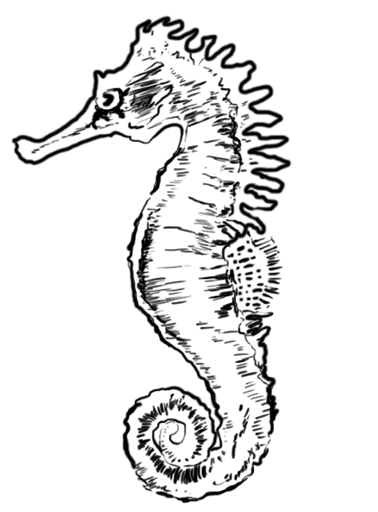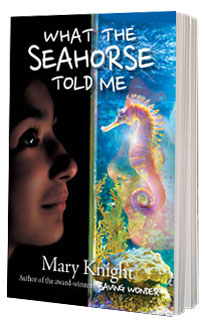
“Seahorses wear their skeletons on the outside,” the old man in the booth tells me. “When you dry them out, they hold their shape!” He sounds excited, like this is the greatest news since the invention of the cell phone.
But I’m suspicious. And bored. And pooped. I mean, my parents and I have been trying to have fun and “be a family” in Sarasota, Florida for the entire week. It’s exhausting. And now, before heading back to Seattle, Mom insisted on making one last stop at this pathetic, beach-side flea market where some guy is trying to sell us his over-priced souvenirs.
“What a way to make a living,” Mom says to Dad under her breath, dragging him off to the next booth. “Come on, Sophie, let’s go.” I’m about to follow, but the vendor keeps yacking.
“Here, little miss … wanna hold one?” Before I know it, I’m holding a bleached-white seahorse in the palm of my hand. I stare at the weightless frame of this delicate creature that once had a life, when suddenly everything goes black.
Later, they’ll say I started shrieking at the top of my lungs, but all I remember is this white-hot, searing pain, like my skin had been dipped in acid and was melting right off the bone. Next, I’m running with an armload of seahorse souvenirs, heading for the ocean, tourists scattering every-which-way. When Mom and Dad finally catch up with me, I’m belly-deep in ocean water, as tiny, ghost-white skeletons in the shape of S’s float in and out with the waves.
They do not sink.

1.
Camouflage
A seahorse alters its color, texture, and even its shape, to blend into its surroundings.*
*From the sixth-grade report, "Getting to Know the Seahorse," by Sophie Kai Bender
The incident in Sarasota wasn’t the first time this kind of freaky thing happened. Usually, when I touch a live animal, I can sense what they’re feeling. If I had known my psycho-telepathic-weirdness happened with dead things, too, I would have avoided that seahorse skeleton like the plague.
I started Googling seahorses as soon as I got home. It didn’t take long to figure out why I lost it. According to Wikipedia, about a million seahorses are harvested from the ocean every year for souvenirs like the one I held in my hand. While the seahorses are still alive, they’re often left out to dry in the boiling hot sun. That feeling must be so intense for them, that somehow the memory of it gets stuck in their bones and remains there even after they die, which would explain why I felt that searing hot pain when I held those skeletons in my hands. Not fun.
With live animals, it’s usually not so awful. Whenever I touch the neighbor’s cat, for instance, all kinds of pictures and feelings zip through me—mostly skittering mice and flitty birds and a twitchy feeling of being on high alert—or, if he’s basking in the sun on a cool day, I might feel a flood of warmth settle over me like a fuzzy blanket. It feels like knowing an animal from the inside out.
The first time it happened was four years ago when I was eight, a few months after my baby sister died. I was at my friend, Ashley’s house, and we were passing her gerbil back and forth. I remember how happy I was to be there, especially since everyone at my house was always so sad. Every time it was my turn to hold the gerbil, the room looked all rounded and blurry, like I was seeing it through a bubble, and it felt like I was being tickled on the inside.
“Here!” I giggled. “Take him! You’ve got to feel this!”
“Feel what?”
“The tickle. It makes you want to run.”
She looked at me like I’d grown two heads.
“He wants to run in his plastic ball,” I said quietly. “Can’t you tell?”
“Einstein doesn’t talk,” she said, and shoved him back into his cage.
That’s when I knew I was a freak.
The only other time I really lost it was in front of my classmates on a third-grade field trip to a dairy farm. I reached out and started to pet one of those poor, miserable cows who were being milked by a machine inside this stinky old barn. Her mind was all darkness and mud—no green, no sun—just this big empty missing, and I began to cry. Fortunately, Dad was there as a chaperone to settle me down, even though he had no clue what was going on. In fact, I’ve never told my parents about my weirdness. I don’t want them to worry any more than they already do.
When we discussed our field trip the next day, our teacher told us how the farmer takes a cow’s calf away from her soon after its birth, so the milk she produces for the calf can be sold to us humans instead. That’s when it hit me—why I felt that big empty sadness.
“She’s missing her calf!” I blurted out, and everyone started laughing.
For days afterward, the mean boys in my class would come up behind me and shout, “Moo!” or tease me on the playground with moaning cow sounds.
Never again.
From that moment on, I promised myself I’d never touch an animal in front of other kids. That also meant I could never have a close friend. A friend might find out about my psycho-telepathic-weirdness and next thing you know, it’s all over school. No, from then on, I hid my weirdness and anything else that might make me stand out.
For the most part, it’s worked. Everybody’s forgotten about the cow incident, and I get along fine now with most of the kids in my sixth-grade class. I don’t accept invitations for sleepovers or birthdays, though. You can never tell what memories someone’s pet might be holding onto, and if I accidentally touched one of them? Well, like I said, you never know…
I also tend to agonize over the fate of the poor animals or insects I see along the road, like the butterflies that hit our windshield in spring. Mom’s always telling me, “You’re being overly sensitive, Sophie,” and “You’ve got to learn to toughen up, Sophie.”
Dad’s a different story. He never tells me to “buck up” like Mom does. No, whenever I’m having a hard time about something—like that incident in Sarasota—Dad tries to make it up to me somehow. Which is why I’m sitting in my living room in front of an aquarium at this very minute staring at a live seahorse.
And I think he’s pregnant.
That’s right. I said, “he.”
Weird, huh?
When my teacher, Ms. Lovejoy, found out how obsessed I was with seahorses after spring break, she suggested I write a report on them. “Dive into your obsession!” she said. “Write what inspires you!”
This is how I came to know that seahorses are one of the few species where males carry the young. A female will shoot up to 1,500 eggs into the guy’s front pouch where he fertilizes them and carries them to term, anywhere from two to four weeks. When I came to that part in my class report, one of the boys said, “Eeeewww … that’s gross,” but Ms. Lovejoy said, “Hey, it’s science and I think it’s cool!”
Anyway, a few hours ago, I had just come back from my grandparents’ house where I’d spent the first week of summer vacation, and there was Dad, his chest all puffed out with pride, standing by the aquarium in our living room. Nothing special about that. The aquarium’s been there for as long as I can remember in the home entertainment space between the bookshelves. “Better than watching TV,” Dad used to say, when the tank had water and fish in it.
When my baby sister died, Dad lost interest in the aquarium, which is why I couldn’t imagine what had him so excited. Mom’s always hated that “slimy, sloshy thing” in her otherwise neat and tidy, black and white living room. After the last of the clownfish died, I figured Dad was getting ready to sell it.
“So, you got me some seaweed?” I said, trying to sound happy. I could tell he’d redone the interior with some new plants and a few pieces of orange coral. The filter hummed and gurgled, creating water currents in an otherwise empty tank.
“Look closer,” he said, rocking on the heels of his feet.
I got down on my knees, pulled a chunk of hair back from my face where it always seems to be in the way, and peered into the aquarium. I expected to see a fish hiding in the weeds, but nothing was swimming. Dad bent down to look with me, and I could see our reflections in the shiny glass—two moon-shaped faces with thick dark hair and large, brown eyes. Unlike me in that moment, however, Dad was still wearing that goofy grin of his, so I kept looking for my “surprise.” Maybe it’s a bottom feeder, I thought, as I searched the tiny pink pebbles along the floor of the tank. Still nothing.
Out the corner of my eye, I felt more than saw the tiniest flick. And there he was, all greenish brown and curved and bony (except for his extended belly) with a long snout and a knobby tail curled around a strand of seaweed. There were spiky things sticking up all over his head like one of those punk rockers Dad likes to watch on the music channel. One of his round, bulging eyes was fixed on mine. Or so it seemed.
“Oh, a seahorse,” I breathed. “Hello.”
He didn’t answer back. And he didn’t blink (no eyelids). But I could have sworn he nodded his horsey-headed snout ever so slightly in my direction.
“Thanks, Dad,” I whispered, as my brain fired up that flashback from Sarasota I wish I could forget.
“I hope you like it.” Dad straightened up, stretching. “I thought it might help, you know, make another memory to replace the bad one.”
“Sure, Daddy. You’re the best.” I stood up and gave him a big hug. It’s been a long time since I’ve called my father “Daddy,” but I just couldn’t help it. I knew what he was trying to do.
Unfortunately, it isn’t working.
Copyright 2024 Mary Knight

